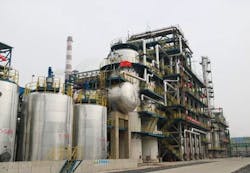China Petroleum & Chemical Corp. (Sinopec) subsidiary Wuhan Petrochemical Co. Ltd. has commissioned the first commercial-scale revamp of a hydrogen fluoride (HF)-based alkylation unit at its 161,000-b/d refinery in Wuhan City, Hubei Province (OGJ, July 8, 2019; Jan. 7, 2019, p. 61).
The 7,500-b/d unit, based on composite ionic liquid (IL) alkylation technology and commissioned on Jan. 21, 2020, has been operating at reduced capacity due to decreased fuel demand as a result of the COVID-19 pandemic, said Well Resources Inc., licensor for Beijing-based China University of Petroleum’s (CUP) Ionikylation process, on Apr. 15.
Sinopec previously commissioned an Ionikylation unit of similar capacity at subsidiary Sinopec Jiujiang Co.’s 161,000-b/d refinery in Jiujiang City, Jiangxi Province (OGJ Online, Apr. 2, 2019).
Commissioning of Sinopec’s newly revamped Wuhan unit follows PetroChina Co. Ltd.’s—the publicly listed arm of state-owned China National Petroleum Corp. (CNPC)—startup of a 3,000-b/d brownfield alkylation unit based on Ionikylation technology in November 2018 at subsidiary Harbin Petrochemical Co. Ltd.’s refinery in Harbin City, Heilongjiang Province, as well as the January 2019 commissioning of a 1,000-b/d Ionikylation unit at subsidiary Golmud Petroleum Refinery’s 20,000-b/d refinery in the Qinghai-Tibet Plateau of Golmud City, Qinghai Province, China, according to Well Resources.
Refiners in the Asia-Pacific region are increasingly turning to Ionikylation alkylation technology—which uses a proprietary composite IL catalyst that eliminates reliance on more dangerous, corrosive, and hazardous chemicals such as HF and sulfuric acid—as they seek to expand alkylation capacity to safely produce low-sulfur, higher-octane alkylate that complies with more stringent clean-fuel standards such as China 6-quality specifications (equivalent to Euro 6-quality standards).
About the Author
Robert Brelsford
Downstream Editor
Robert Brelsford joined Oil & Gas Journal in October 2013 as downstream technology editor after 8 years as a crude oil price and news reporter on spot crude transactions at the US Gulf Coast, West Coast, Canadian, and Latin American markets. He holds a BA (2000) in English from Rice University and an MS (2003) in education and social policy from Northwestern University.

